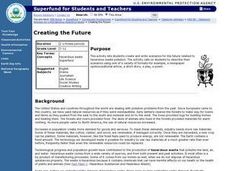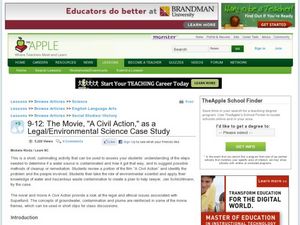Curated OER
Hazardous Waste Cleanup Methods
High schoolers examine how hazardous wastes are cleaned up. They work together to identify the positives and negatives of cleaning up certain hazardous wastes. They answer questions as part of the activity.
Curated OER
Making Decisions About Hazardous Waste Cleanup
Students work together to role play a situation which shows the decision-making process in cleaning up hazardous waste. They identify participates in the Superfund and make judgments about how cleanup would help an area. They share...
Curated OER
Hazardous Waste Issues in the News
Students work together to research hazardous waste in the news. They discover how large the hazardous waste issue is. They complete an experiment and discuss how the issues affect their community.
Curated OER
Examining a Hazardous Waste Site
Students identify activities that produce hazardous waste. They examine how contaminants are spread in air and water. They work together to create a model to show how the contaminants move through water.
Curated OER
Federal and State Laws on Hazardous Waste
Students examine how laws on hazardous waste is developed and enforced. They work together to discover how statutes are passed as well. They complete an activity to end the instructional activity.
Curated OER
How Hazardous Substances Affect People
Students examine the health effects of hazardous waste on people. They work together to complete an experiment in which worms are exposed to chemicals. They discuss the results of the test.
Curated OER
Environmental Awareness — Think Global, Act Local
Students identify the different hazardous wastes and the dangers they post to the environment. In this physical science lesson, students brainstorm ways to dispose them properly. They create a short story, song or poem to conclude the...
Curated OER
Creating the Future
Students work together to develop and write scenerios for the future of hazardous waste cleanup. They share their scenerios with the class. They complete activities as well.
Curated OER
Storage, Use, Pollution,& Clean Up of Water
Students synthesize water resource educational posters into class presentations based on the poster's theme. Working in groups, they make presentations on wastewater, water uses, watersheds, groundwater, wetlands,water quality, and...
Curated OER
9-12: The Movie, "A Civil Action," as a Legal/Environmental Science Case Study
Students analyze information to determine how they can help a community that has been affected by water contamination. In this environmental science lesson, students watch portions of the movie "A Civil Action" and discuss specific...
Curated OER
Talking Trash
Define vocabulary related to global waste. Creative thinkers review and illustrate terms for the Global Garbage Picture Dictionary. They play a vocabulary game in which co-operative skills among players in encouraged. A great way to...
Curated OER
EPA's Superfund Program
Young scholars work together to gather information about the EPA's Superfund program. They discuss how to improve human health and the environment. They discover how hazardous wastes are characterized and cleaned up.
Salt River Project
How Do We Clean Polluted Water?
How do we clean up oil spills and other pollutants in the water? Explore water treatment strategies with a set of environmental science experiments. Groups remove oil from water, work with wastewater treatment, and perform a water...
Curated OER
Exploring the Elements of Stewardship
Students examine stewardship activities and issues relating to the Department of Energy's activities on the Oak Ridge Reservation. They identify seven elements of an effective stewardship program, and conduct Internet research.
Curated OER
Identifying Risks at a Superfund Site
Students work together to discover the type of risks at Superfund sites. They examine how sites are found and where to report hazardous sites. They evaluate the activities of the government to protect its citizens.
Curated OER
The Numbers Game
Students examine how to calculate the part-per-million and part-per-billion units used to measure contaminant concentrations in the environment. They calculate ratios, take a quiz, analyze a sample chemical spill, and determine if...
Curated OER
Subsurface Contamination of Groundwater
Students evaluate the potential problems associated with underground storage tanks. They research the potential hazards from various subsurface pollutants and simulate a superfund site cleanup.
Curated OER
The Risks of Everyday Living
Students compare their perceptions of risk to the perceptions of scientists and risk professionals. in small groups, they evaluate risks on a scale of 1 to 10 for the average American on a yearly basis.
Curated OER
Dealing with Chemical Emergencies
Students examine how all levels of government react to chemical emergencies. They identify activities which could lead to an emergency. They discuss how they respond to contaminants released into the air.
Curated OER
I Won't Live in a Toxic World
Students examine four separate environmental health issues using fish-bowl technique, and discuss roles of both government and citizens in maintaining a pollution-free environment.
Curated OER
What the Community Can Do
Students examine how the EPA encourages communities near Superfund sites to become involved in the Superfund process. They read informational text, and participate in a role-play activity.






















